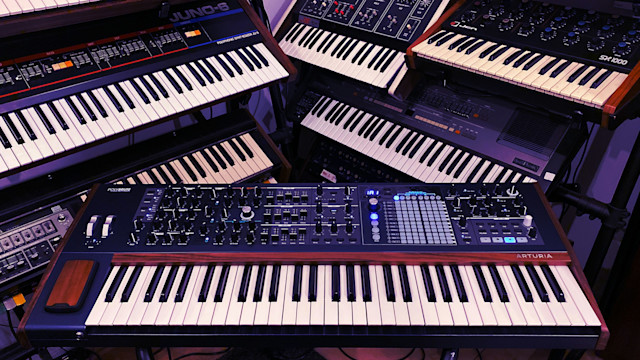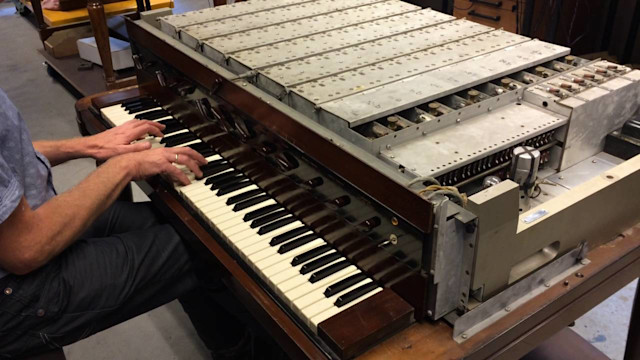The History of The Synthesizer: How Music Became Digital
January 30, 2024 — Learn the history of the Synthesizer and how it changed the world of music production. How is the instrument used today and how can you incorporate it into your music production?

Music, today, spans genres and decades with ease. It’s easy enough to find classic gems and never-before-heard releases through the myriad streaming platforms and music apps available.
Whether you’re listening to chart-topping hits from the 70’s, or brand new underground music where you’re the fifth stream, worldwide, you might’ve noticed that synthesizers have become ubiquitous.
Synthesizers have changed a lot over the years, but even today’s advanced DAWs provide digital “synths” that producers love to use and listeners love to hear. But where did it all start? Have you ever wondered who made the first synthesizer, or what it sounded like?
Does it surprise you to learn that digital music was being made as early as the 1950s? What about earlier? If your interest is piqued, read on! We’ll be exploring where synthesizers came from and the journey that’s taken us to where we are today. Let’s hit play.
What is a synthesizer in music?
A synthesizer is an electronic musical instrument that generates audio signals to produce a wide variety of sounds. These sounds are created through the manipulation of electromagnetic frequencies and waveforms.
While synthesizers often come with a keyboard interface, making them visually similar to pianos, they are distinct in their ability to create and modify sounds electronically, offering vast versatility in sound production.
Leon Theremin playing his own instrument, the Theremin - one of the early synthesizers
Early Roots - 20th Century
While electric instruments far predate the devices that we would easily recognize as synthesizers today, they began to come into clearer focus in the 20th century. Devices, like the theremin — named for its inventor, Leon Theremin, are often seen as early precursors to today’s more advanced synthesizers.
The Theremin - Circa 1920
Also known as an aether phone, the theremin operates using electronic frequencies to produce haunting noises that the user can control by moving their hands around near the two antennas on the device. While this wasn’t the first electronic instrument, it is often seen as an important pioneer in the field of electronic music. Theremins were used extensively in films in the 20th century, and their sound is often now reminiscent of old sci-fi and horror movies.
Ondes Martenot - 1928
While the theremin and the Ondes Martenot were both patented in the same year — 1928, the theremin had already been in existence for nearly a decade by this time, having been originally invented but not patented as early as 1920. The Ondes Martenot is similar to the theremin in the sounds that it makes, but distinct in its operating principles. It can be operated by a keyboard — or operated by moving a finger ring along a wire, called a “ruban,”(French for “ribbon”) to achieve precise pitch control to produce haunting sounds similar to that of a theremin.
Novachord - 1939
As the world was being plunged into a second global conflict, not all was bleak. The Novachord was introduced in the 1939 world fair, and is often considered the world's first polyphonic (meaning that it can play more than one note simultaneously) synthesizer. With a wooden body and a familiar white and black keyboard, the Novachord appears strikingly similar to a piano. However, it was a highly capable electronic instrument that could produce incredibly haunting electronic sounds. It was made up of over a hundred vacuum tubes, making it a very complex device for its time. It also was a heavy machine — weighing in at over 500 pounds.

The Novachord was introduced in the 1939, often considered the world's first polyphonic synth
RCA Mark II Sound Synthesizer - 1957
In 1957, the RCA Mark II synthesizer marked the first programmable electronic music synthesizer. While it was far cry from the synthesizers we might see being produced today, this was an important achievement that likely had a significant impact on the trajectory of what was to come. It was installed in the Columbia-Princeton Electronic Music Center, a cutting-edge facility that is now known as the Computer music Center, and is the oldest research center for computer and electronic music in the United States.
Moog Synthesizer - 1964
Even if you’re not particularly passionate about synthesizers, there’s a good chance you’ll recognize the iconic Moog synthesizer — both its name and likely its distinct sound. (Switched-On Bach, anyone?) The Moog synthesizer set the stage for later synthesizers, effectively establishing standards for the features that later machines would offer.
Among the most notable of these were voltage-controlled oscillators, which allowed users to generate a wide array of sounds by oscillating note frequencies. It also featured voltage-controlled filters for shaping and modifying the timbre of the sound, and voltage-controlled amplifiers to adjust the volume of the output sound. These components were revolutionary because they enabled users to more precisely control and manipulate sound electronically, which at the time was groundbreaking.
ARP Odyssey - 1972
The Moog synthesizer made waves, and the next major shift became that towards more portable devices. Moog, in 1970, released the Minimoog Synthesizer, with which the ARP Odyssey competed. The ARP Odyssey was highly portable and offered duophonic capabilities, meaning it could play two notes simultaneously. Its distinctive sound was an important part of the 1970s, and is easily recognizable today. It featured an easy-to-use interface, with which users could control a high pass filter, a low pass filter, note envelopes (attack, sustain, delay release), and even LFO.
Juno 106 - 1984
In 1984, the Roland Juno 106 was released. Some readers may recognize Roland as the maker of the iconic 808 drum machine, for which trap bass drums are often still modeled. (They’re often simply referred to as “808s.”)
You also may recognize the sound of the Juno 106, which became characteristic of the 1980s. To this day, the sound is so prized that contemporary musicians — such as Kevin Parker of Tame Impala — are known for using it. It’s often mistaken for the synthesizer used to create the arpeggio in the Stranger Things introduction song, though it was not; that was created using an Oberheim TVS-1A.

The Moog synthesizer (1984) set the stage for later synthesizers.
Changing Times 1990s - Onward
The 1990s saw a renewed interest in rock and roll, especially the new genres of alternative rock and grunge, which are often seen as exemplary of that time period, but synthesizers continued to be important in the 90’s — especially with the rise of electronic dance music (EDM) and hip hop. Samplers became an important part of the conversation, enabling hip-hop producers to sample music in their beats. Meanwhile, house music was taking off, and new genres were emerging left and right, such as drum & Bass (DnB), Acid Bass, and hardstyle — which would see a notable resurgence in the 2020s.
Connecting Synthesizers to Personal Computers
While synthesizers are technically a form of computer themselves, the decade saw a significant shift towards more powerful personal computing in music creation. Connecting a synthesizer to a computer — one much more advanced, became a common model.
This period was characterized by the rise in popularity and advancement of Digital Audio Workstations (DAWs), which would eventually evolve into the sophisticated platforms we recognize today, such as Soundtrap, Ableton Live, FL Studio, and Logic Pro.
Important to this shift was the widespread adoption of the MIDI standard, which enabled a connection between electronic instruments, including synthesizers, and computers. This integration became crucial, paving the way for systems that we use today to produce digital music.
How to use a MIDI synthesizer in Soundtrap
The Rise of Cloud Computing - 2010s to Present
While cloud computing has its earliest roots as far back as the 1960s, the 2010s saw advanced cloud computing services go mainstream, enabling the use of cloud DAWs. Over the years as cloud computing and infrastructure has become even more advanced and capable, we’ve seen the capabilities of cloud-based DAWs grow as well.
Today, users can access services like Soundtrap and create collaborative music of all kinds in real-time with other users such as friends and colleagues irrespective of location.
Today and Beyond
Today’s users, as we’ve mentioned, can access powerful tools like Soundtrap, even if they don’t have a powerful and expensive workstation. Since the computing power of these systems is now cloud-based, nearly any device capable of using a sufficiently up-to-date web browser can be used to create incredible sounds.
The use of plugins and mixing software has proliferated extensively, enabling users of modern-day DAWs to access some of the iconic sounds — or those designed to emulate them — that we’ve discussed, seamlessly. Easier than ever before to create, today’s digital music is truly widely accessible.
What’s Next?
It’s hard to say what lies ahead in the world of music, but today’s morning looks bright. With the rise of cloud computing that’s more powerful than ever, coupled with the advancement of collaborative tools just like Soundtrap, today’s electronic producers have the world at their fingertips. This trend will likely continue, further enabling new sounds to emerge as young and old artists alike embrace this technological shift. What tomorrow holds is anybody’s guess, but the advancement of artificial intelligence may further hasten the advancement of music-creating processes. In many ways, playing a synthesizer, or connecting a synthesizer to the computer has never been easier.
Remember — if you’re looking for an amazing way to create incredible sounds, that’s what we’re here for. Check out Sountrap’s incredible collaborative environment today and discover your everywhere studio.
Soundtrap — the online music studio
Making music is more than just a hobby — it’s a form of self-expression, a way to unleash your creativity, and a means for you to bring your unique voice to the world.
Soundtrap is the ultimate audio production software for music makers and producers to easily collaborate and create music online, with thousands of audio loops, instruments, and samples only a click away.